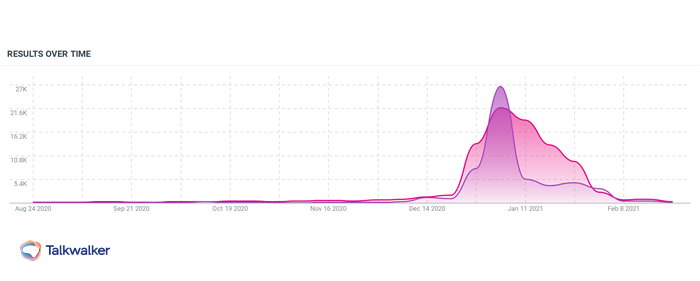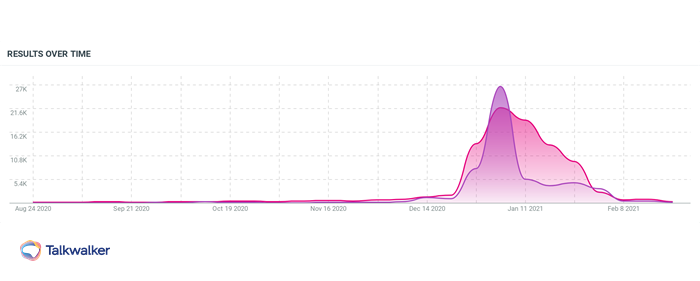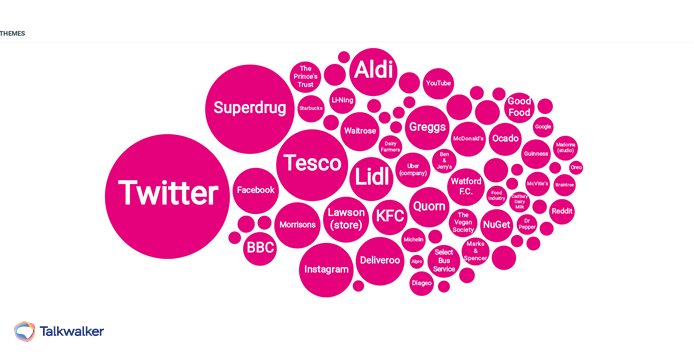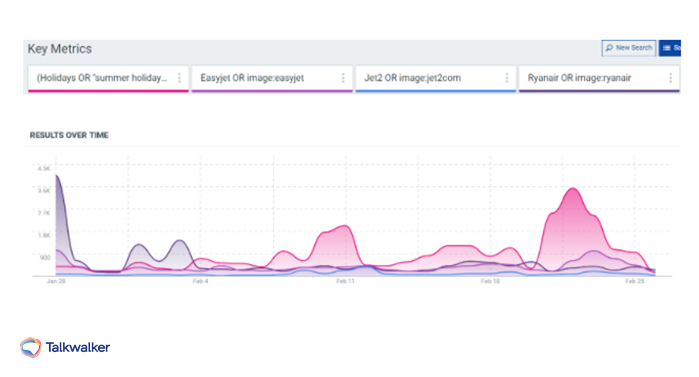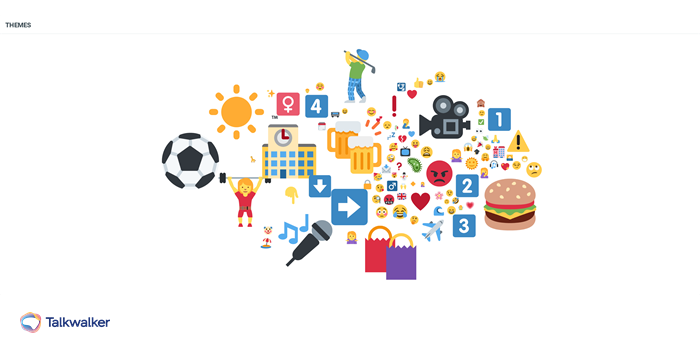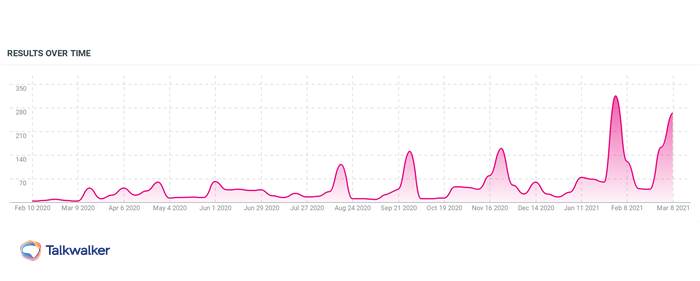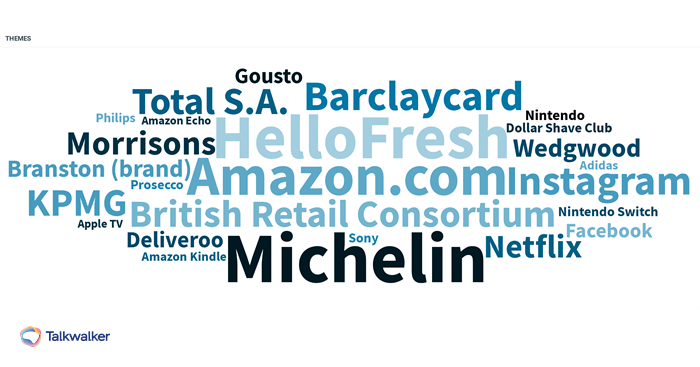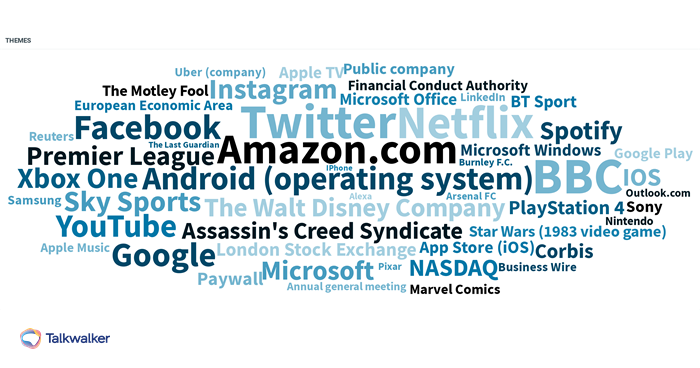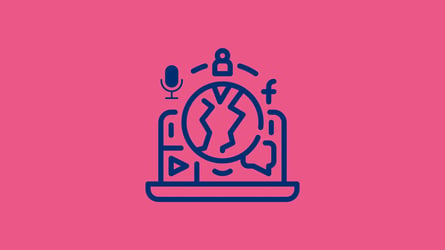Track consumer trends to stay in tune with your customers
Going plant-based for Veganuary
Starting off the year, 2021 wasn’t much different from previous years, with consumers taking the opportunity to kick-start their healthy New Years’ Resolutions. Recently, we’ve seen more people ditch “Dry January”, instead opting for “Veganuary”, i.e., going vegan for the month of January. In fact, 2021 saw the highest number of people sign up to the Veganuary challenge ever in the UK. A whopping 500K committed to only eating plant-based food for the month.
Whilst there was a bigger peak of “Dry January” mentions (purple), overall there were more mentions of “Veganuary” (pink).
This reflects a wider consumer trend towards plant-based diets and vegan lifestyle. Recent research from the investment bank UBS on plant-based alternatives to meat, showed an increase in the number of people trying new products. Between March & November 2020, the proportion of people who tried meat alternatives rose by 5%.
Did you hear! @Asda has announced it will trial a VEGAN BUTCHER concept at its Watford store next week The ‘Veelicious’ counter will offer a selection of products such as facon, bean burgers, meat-free meatballs and black pudding! How cool is that!#Veganuary2021 pic.twitter.com/4UVgkBuJ90
— Veganuary (@veganuary) January 5, 2021
ASDA launched a trial vegan butcher in one of their stores to coincide with Veganuary.
And it’s not just food where people are looking to go vegan, but other popular consumer products such as make-up, cosmetics and leather goods. All this taps into one of the biggest trends we identified in our recent Social Media Trends report: the rise of socially conscious consumers. From social justice to environmental causes, these factors are impacting the buying decisions of consumers, particularly from younger generations. Brands that are looking to attract this growing customer group should really consider how they could tap into this trend. High street pharmacy and cosmetics retailer, Superdrug, took Veganuary as an opportunity to highlight their vegan make-up range.
Are you making any vegan-friendly swaps this #Veganuary? We are here to help with our exclusive @BbySuperdrug products, starting with the Filter Finish Foundation
A great everyday foundation with medium coverage, ideal for a quick WFH makeup look! ✨ https://t.co/CODXkO0f71 pic.twitter.com/oDYYwI22EO
— Superdrug (@superdrug) January 13, 2021
And it paid off, as they were one of the most referenced brands linked to Veganuary.
How are consumers talking about your brand?
Travel in the time of COVID
Whilst many had hoped that talk of COVID-19 could be left in 2020, unfortunately the pandemic was still at the forefront of most conversations. After months of strict lockdown, UK PM, Boris Johnson, announced the roadmap for re-opening. Shortly after, shares in UK-listed travel companies were given a boost as the population began to plan long-awaited holidays. Airlines in particular saw a boost in their share prices, and this is reflected in the number of mentions of major companies.
Mentions of major airlines alondside mentions of 'holidays' increased around the announcement of COVID-19 restrictions being eased
Airlines such as Ryanair took advantage of the announcement to optimistically launch a host of summer travel deals.
hello, summer
we have a special 10% off UK-only flash sale on https://t.co/LTBSLnnrr9 now
— Ryanair (@Ryanair) February 23, 2021
In addition to conversations about holidays and foreign travel, people were talking more broadly about all the things they're excited to do once the lockdown restrictions are finally lifted on 21st June. There were many references to going to the local pub for a few pints, as well as going to the cinema or playing their favourite sports.
Emojis relating to drinking and eating out, along with playing sports were some of the most used in relation to the announcement of COVID-19 restrictions being relaxed
These were also reflected in some of the memes created soon after the announcement.
21st of June 2021, sometime just after lunch. pic.twitter.com/BRZ2IAd9pU
— Chris Olivant (@olly2518) February 22, 2021
An example of one of the many memes about 21st June that went viral.
It’s clear that after living through months of strict lockdown, the British public are looking forward to life returning to some form of normality in summer 2021!
Stay in tune with your customers
Meal delivery kits: the new going out?
One of the industries that has been most affected by the pandemic is the hospitality sector. With bars, restaurants and cafes being forced to close, except for takeaways, for long periods of time to prevent the spread of coronavirus, the sector has had to find ways to adapt in order to survive. One innovative solution that many bars and restaurants have turned to is home delivery kits. This appears to have really taken off during the second and third lockdowns in the UK - in the last 6 months, mentions of meal and drink kits have increased greatly.
There have been a stead increase in the volume of mentions of home delivery meal and drink kits over the last 6 months
Once the realm of the likes of HelloFresh, during the pandemic, high-end and exclusive restaurants moved into the delivery space, enabling consumers to have a taste of luxury in their own homes. One of the most mentioned brands when talking about home delivery meal kits was Michelin, showing that people are taking advantage of experiences they might not have otherwise been able to enjoy. In normal times, many of these restaurants have long waiting lists for reservations, and come at a higher price point. By offering this at home service, high-end restaurant brands have also been able to broaden their customer base.
This theme cloud shows that Michelin is one of the brands most associated with home delivery meal and drink kits
The format of these varies - in some cases ingredients and recipes are provided, in others the meals are prepared and just need to be finished at home. And this is not just limited to food, with a number of bars sharing make-at-home cocktail kits.
Dinner by Heston will reopen on Aug. 1, with a new outdoor Garden Terrace. The main dining room opens Sept. 1. On July 24, Dinner at Home launches, with dishes such as Meat Fruit available for collection after you order online or via the phone. https://t.co/rOB4qeCwX2 pic.twitter.com/RkYDgLOpIR
— Richard Vines (@Richardvines) July 21, 2020
Discover trends in your industry
Subscription services on the rise
In addition to home delivery meal kits, subscription services in general have been on the rise. By August last year, the subscription economy was worth £323m, and set to continue growing, with households typically spending around £552 a year on sign-up services. A large percentage of subscriptions are for tv and music streaming services such as Netflix, and Spotify. Amazon Prime came out on top when it came to the most subscribed to service in the UK.
Most of the brands mentioned in conversations around subscriptions were for tv and music streaming platforms
However, the benefits of this model are being accessed across a number of industries, and we’ve seen some interesting products and services launch as a result. For example, subscription services such as Patreon and Substack are being used by those in creative industries to monetise their work. These platforms allow fans and supporters of different creatives to pay a subscription fee to receive regular, exclusive content. This has provided an additional way for creative industries that have been impacted by the pandemic to earn an income.
COVID-19 continues to shape consumer trends
Whilst many people may be tired of hearing about COVID-19 and the pandemic, it’s clear that it has greatly changed people’s lives and how they interact with brands and content. Like it or not, it’s likely to continue shaping consumer trends in the UK for the foreseeable future. For brands that are looking to not just survive, but thrive, over the coming months, it’s important to get a handle on these trends and learn how to adapt quickly.

